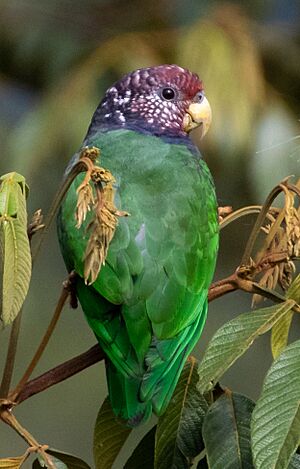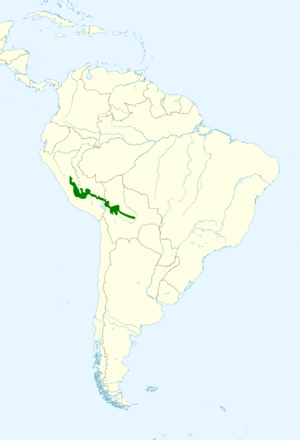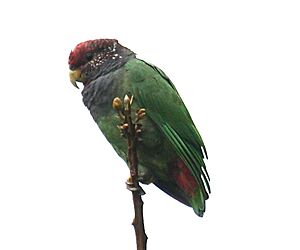Plum-crowned parrot facts for kids
Quick facts for kids Plum-crowned parrot |
|
|---|---|
 |
|
| Conservation status | |
| Scientific classification | |
| Genus: |
Pionus
|
| Species: |
tumultuosus
|
 |
|
| Synonyms | |
|
Speckle-faced parrot (Plum-crowned), P. tumultuosus tumultuosus |
|
The plum-crowned parrot (Pionus tumultuosus) is a beautiful bird found in the forests of Bolivia and Peru. It belongs to the parrot family, known for its colorful feathers and ability to mimic sounds. This parrot gets its name from the special plum-colored feathers on its head.
Contents
About the Plum-Crowned Parrot
How Scientists Classify This Parrot
Scientists who study birds often group them together based on their features. This is called taxonomy. For the plum-crowned parrot, not all scientists agree on its exact family tree. Some groups, like the International Ornithological Committee, think it's a unique species. This means it's a distinct type of bird.
However, other groups, like the South American Classification Committee, believe it's a subspecies. They think it's a type of speckle-faced parrot (P. tumultuosus). This means it's a special kind of speckle-faced parrot, but not a completely separate species. Scientists keep studying these birds to learn more and decide the best way to classify them.
What the Plum-Crowned Parrot Looks Like
The plum-crowned parrot is about 29 to 30 centimeters (11 to 12 inches) long. That's about the length of a ruler! It weighs around 229 grams (8 ounces), which is like the weight of a small orange.
Adult parrots have a lovely plum-colored forehead and crown, which is the top of their head. The rest of their face, throat, and chest are a dull purple with small pink spots. Their back, wings, and belly are green. Under their tail, the feathers are red, and the rest of their tail is green with some blue on the outer feathers. Their beak is a pale yellowish color, and their eyes are dark with grayish skin around them. Their legs and feet are gray.
Younger parrots look a bit different. They have a brownish-green crown and chest. They also have white spots near their ears and yellowish-green feathers under their tail.
Where Plum-Crowned Parrots Live
These parrots live on the eastern side of the Andes Mountains. You can find them from central Peru all the way through Bolivia. They love to live in humid forests, especially cloud forests. These are forests high up in the mountains where clouds often hang low. They particularly like areas where bamboo grows. Sometimes, they also visit nearby farms to find food.
Plum-crowned parrots usually live at high elevations. They are most often found between 2,000 and 3,300 meters (6,600 and 10,800 feet) above sea level.
Plum-Crowned Parrot Behavior
Movement
Plum-crowned parrots are a bit like travelers. They are somewhat nomadic, which means they move around from place to place. They don't always stay in the same spot.
Feeding Habits
We don't know a lot about what plum-crowned parrots eat or how they find their food. However, we do know they enjoy eating fruits. They have been seen eating fruits from Turpinia paniculata trees and other trees in the Clusiaceae family. They also visit corn fields to eat the maize.
Reproduction and Life Cycle
Scientists believe that plum-crowned parrots lay their eggs in November and December. We don't know much about how they raise their young in the wild. But in zoos, female parrots usually lay about four eggs. The eggs hatch after about 26 days. Like other parrots in their group, they probably build their nests inside holes in trees in the wild.
Vocalization
When plum-crowned parrots fly, they make a low, harsh sound that sounds like "crrah." When they are resting on a branch, they make many different "conversational" calls. Some of these calls sound a bit like they are talking through their nose.
Conservation Status
The IUCN (International Union for Conservation of Nature) has looked at the plum-crowned parrot's situation. They have listed it as a species of "Least Concern." This means that, for now, they are not in immediate danger of disappearing.
The parrot lives in a fairly large area. However, we don't know exactly how many plum-crowned parrots there are. Scientists believe their numbers might be going down. No major threats have been found that would put them in immediate danger. They are generally considered to be uncommon and found only in certain places.



